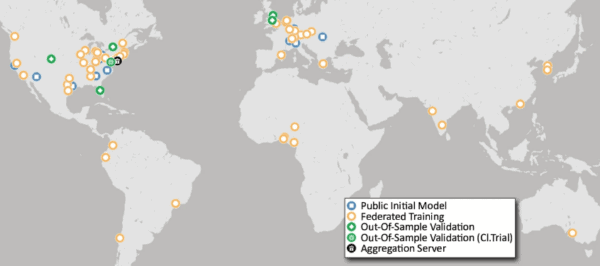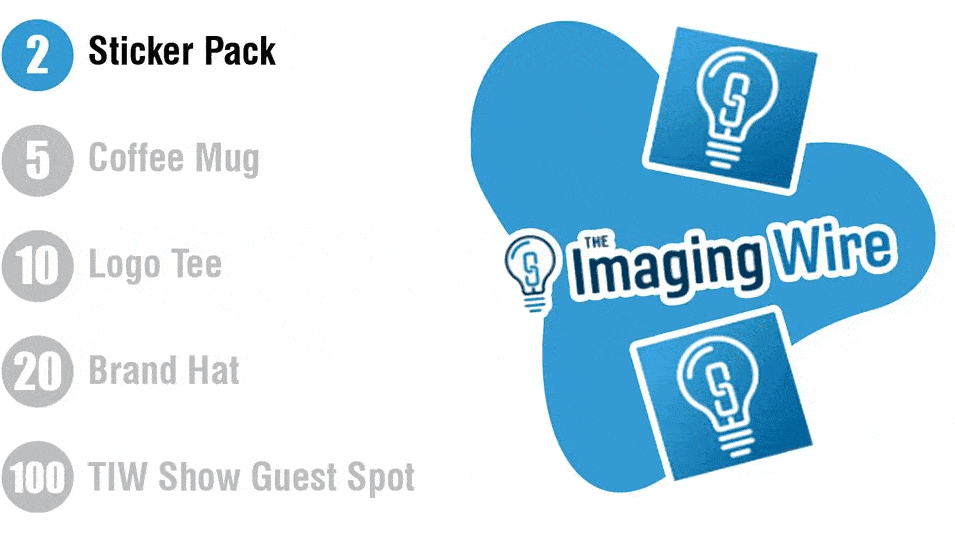|
Federated Learning Milestone | Navigator Impact
December 15, 2022
|
|
|

|
|
Together with
|

|
|
|
“The lungs are as clear as my conscience; redolent of a dense rainforest. It’s probably heart failure but I must remonstrate that the heart should not be blamed directly.”
|
|
A radiology report poem by UK Radiologist, Paul McCoubrie.
|
|

|
|
AI insiders celebrated a massive new study highlighting a federated learning AI model’s ability to delineate glioblastoma brain tumors with high accuracy and generalizability, while demonstrating FL’s potential value for rare diseases and underrepresented populations.
The UPenn-led research team went big, as the study’s 71 sites in 6 continents made it the largest FL project to-date, its 6,314 patients’ mpMRIs created the biggest glioblastoma (GBM) dataset ever, and its nearly 280 authors were the most we’ve seen in a published study.
The researchers tested their final GBM FL consensus model twice – first using 20% of the “local” mpMRIs from each site that weren’t used in FL training, and second using 590 “out-of-sample” exams from 6 sites that didn’t participate in FL development.
These FL models achieved significant improvements compared to an AI model trained with public data for delineating the three main GBM tumor sub-compartments that are most relevant for treatment planning.
- Surgically targetable tumor core: +33% w/ local, +27% w/ out-of-sample
- Enhancing tumor: +27% w/ local, +15% w/ out-of-sample
- Whole tumor: +16% w/ local, +16% w/ out-of-sample data
The Takeaway
Federated learning’s ability to improve AI’s performance in new settings/populations while maintaining patient data privacy has become well established in the last few years. However, this study takes FL’s resume to the next level given its unprecedented scope and the significant complexity associated with mpMRI glioblastoma exams, suggesting that FL will bring a “paradigm shift for multi-site collaborations.”
|




|
|
The Intelerad Cloud
Intelerad just launched its Intelerad Cloud suite of imaging solutions, marking the culmination of over four years of cloud investments and acquisitions. The new Intelerad Cloud allows imaging organizations to adopt a variety of hybrid, public, or private cloud solutions based on their specific needs (including: PACS, VNA, image exchange storage, long-term archiving, disaster recovery, patient portal).
|
|
AI’s Barriers and Benefits
We hear a lot about AI being the next big thing or being immature and overhyped. This set of Blackford Analysis editorials reviews the challenges that are still holding back imaging AI, and the areas that AI is delivering genuine clinical benefits.
|
|
- AR/VR Growth: The FDA’s Digital Health Center of Excellence published its list of all 39 cleared augmented reality / virtual reality devices, with 79% of those clearances taking place since 2019. The vast majority of these clearances targeted radiology and orthopedics (13 & 15), and unsurprisingly most of the orthopedic solutions are also based on radiology exams.
- Philips’ Solutions Centric RSNA: In addition to displaying the scanners that Philips released over the last few years, RSNA 2022 served as a launchpad for Philips’ latest informatics solutions. Philips’ new Advanced Visualization Workspace version places a direct target on AI integration and multi-ology workflows, adding a new cardiac MR suite, a new CT ASPECT Scoring AI solution, and an enhanced CT Liver Analysis tool. Philips also debuted its new zero footprint RIS, which comes natively integrated into the Philips Vue PACS, combining core clinical/administrative RIS features with new patient-oriented self-scheduling and check-in features.
- Navigator Impact: A Cleveland Clinic study showed that employing imaging service navigators (ISNs) to handle non-interpretive tasks can have a major impact on radiology department communications. Analysis of the six months before and after Cleveland Clinic appointed ISNs revealed a 49% increase in overall communication rates (2.196% to 3.278%), with the greatest increases in cases that were urgent or had actionable findings (+94% & +75%). The ISNs cut radiologists’ average daily communication workload from 39 to 11 minutes, and scored an 82% average radiologist approval rate.
- Koios CE Mark: Koios Medical announced the CE Mark approval of its ultrasound AI-based Koios DS thyroid and breast cancer detection/reporting platform. Koios DS already had FDA clearance, is compatible with all major ultrasound brands and all PACS platforms, and might have a head start in Europe through its ultrasound integration partnership with GE Healthcare.
- CMS Prior Auth Rule: CMS proposed a new rule meant to streamline prior authorization by requiring payors to implement additional electronic processes, shorten their response times for physician requests, and provide reasons for denials. Payor advocacy organization AHIP voiced support for the rule in part because it would also establish standardized data exchange processes to help payors transfer data when patients change health plans. If the new rule is finalized, the policies would take effect in 2026.
- Precision CAD Care: An article in The American Journal of Medicine proposes a new treatment approach for coronary artery disease that prioritizes the direct quantification and characterization of atherosclerosis, rather than indirect CAD markers like cholesterol. Combining coronary CT angiography with traditional CV risk-factors and existing clinical guidelines may improve risk stratification, therapeutic decision making, and longitudinal disease tracking. Not coincidentally, the last several years have brought an emergence of startups directly focused on AI-based plaque assessments that would support this document’s proposed approach.
- MRI Online Becomes Medality: The smart folks at MRI Online have been upskilling radiologists across a broad range of modalities for quite a while, giving them good reason to officially rebrand as Medality earlier this week. Medality will continue to offer the thousands of micro-learning videos and scrollable cases that MRI Online was known for, in addition to its new Practice Development Platform intended to similarly help leaders grow their practice and support their team.
- Early Lung Cancer Detection and Survival: A 2006 study using data from the International Early Lung Cancer Action Program (I-ELCAP) marked a major step in the lung cancer screening movement, showing that patients whose cancer was identified by CT screening had an 80% survival rate after 10 years. Fast-forward to RSNA 2022, a follow-up study of 1,285 I-ELCAP participants just showed that these results are maintained over 20 years if lung cancer is detected while still early-stage, including an 80% overall survival rate and 100% survival rate among participants with non-solid or partly solid lung nodules.
- Imagen’s Aorta-CAD Clearance: Imagen Technologies announced the FDA clearance of its Aorta-CAD deep learning tool, designed to help physicians detect aortic atherosclerosis and aortic ectasia in chest X-rays. The cloud-based solution is part of Imagen’s Diagnostics as a Service platform, and is positioned as a diagnostic assistant for “any physician who reads chest X-rays.”
- OOP Costs’ Screening Impact: New research in JACR revealed that patients who incur high out-of-pocket healthcare costs are less likely to continue lung cancer screenings, even when their OOP costs are unrelated to lung cancer screening. The study included 14.9k patients with negative lung cancer screenings (30.5% who underwent repeat screenings), finding that individuals who had annual OOP costs between $1,069- $2,475 (aOR: 0.85) or more than $2,475 (aOR: 0.75) were less likely to attend repeat screenings than patients with under $351 in annual OOPs.
- Philips & MagCorp’s Magnet Alliance: Philips and magnet developer MagCorp entered a research agreement to explore superconducting magnets that might allow more sustainable MRI scanners that don’t require liquid helium for cooling. The partnership continues Philips’ efforts to reduce its MRI helium reliance, most notably through the BlueSeal technology found in its Ambition X MRI that seals a small amount of helium into the magnet during the manufacturing process.
- RedBrick AI’s $4.6M: Image annotation platform company RedBrick AI secured $4.6M in seed funding to expand its customer base and support new product development. The RedBrick platform provides imaging AI developers and researchers with cloud-deployable tools that reportedly reduce annotation time by up to 60%.
|
|
The Power of Deep Learning in Cardiac MRI
See how three hospitals are leveraging GE Healthcare’s AIR Recon DL to improve their cardiac MRI image quality, shorten scan times, and expand their cardiac imaging capabilities.
|
|
- The Hyperfine Swoop Portable MRI has been used to care for children with hydrocephalus at Uganda’s Cure Hospital since 2021, improving imaging access without exposing patients to ionizing radiation. Learn more about the Swoop’s hydrocephalus impact here.
- Check out this Change Healthcare video explaining the difference between single-tenant and multitenant cloud architecture, and how multitenant solutions can improve your efficiency and flexibility.
- See how Dubai-based healthcare leader Aster DM Healthcare leveraged the CARPL platform to connect its doctors, data scientists, and imaging workflows, and support its AI projects and development infrastructure.
- Despite what we’ve been taught, acquiring high SNR MRIs doesn’t always mean longer scan times. Take Canon’s AiCE Deep Learning Reconstruction challenge and see if you can tell which of these brain MRI studies were performed in less scan time with the help of AiCE DLR.
- With ongoing radiologist shortages and higher rates of burnout, there’s a great need for fast, effective, efficient medical imaging technologies – and those factors are driving 2022’s major medical imaging trends detailed in this Arterys report.
- Check out our interview with United Imaging CEO, Jeffrey Bundy, who explores company culture’s central role in medical imaging and how to build, improve, and maintain culture. If you’re ready to improve your organization’s culture, this interview is a great way to start.
- Ready to address burnout on your team? This Novarad report details the main burnout drivers within imaging teams, and the steps radiology leaders can take to prevent burnout.
- Nuclear medicine teams are facing three significant SPECT/CT challenges: balancing dose with image optimization, addressing staffing constraints, and preparing for continued theranostics advances. See how redefining your SPECT/CT standards can address these challenges in this Siemens Healthineers report.
- Annalise.ai doubled-down on its comprehensive AI strategy with the launch of its Annalise Enterprise CTB solution, which identifies a whopping 130 different non-contrast brain CT findings. Annalise Enterprise CTB analyzes brain CTs as they are acquired, prioritizes urgent cases, and provides radiologists with details on each finding (types, locations, likelihood).
|
|
|
Share The Imaging Wire
|
|
Spread the news & help us grow ⚡
|
|
Refer colleagues with your unique link and earn rewards.
|

|
|
|
|
Or copy and share your custom referral link: *|SHAREURL|*
|
|
You currently have *|REFERRALS|* referrals.
|
|
|
|
|